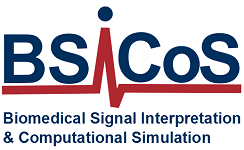-
Proyectos
Physiology-driven signal analysis for guiding cardiac arrhythmia management and therapy – PID2019-104881RB-I00
Fecha de inicio
2020
Fecha de finalización
2023
Coordinador
Juan Pablo Martínez
Funding agency
CICYT (ref. PID2019-104881RB-I00 )
Cardiac arrhythmias are heart rhythm disorders consequence of the abnormal generation and/or abnormal propagation of electrical impulses in the cardiac conduction system. They can originate in the atria or in the ventricles and are directly or indirectly responsible for hundreds of thousands of deaths every year in the EU, with the subsequent costs for health systems (treatment, hospitalization, rehabilitation, disabilities, etc.) Sudden cardiac death (SCD) is the cause of 20% of deaths in Europe and is usually originated by ventricular tachycardia (VT) evolving into ventricular fibrillation (VF), a rhythm that leads to a lack of blood pumping and to the death of the patient if not reversed in a few minutes. On the other hand, atrial fibrillation (AF) is the most prevalent sustained arrhythmia (2% of the total population), especially in the elderly (8.5% among people over 60). Although less dangerous in the short term, it affects the quality of life and leads to added risk of SCD, heart failure, stroke and dementia.
In this project, several of the main technological challenges in relation to these arrhythmias are addressed. One is the non-invasive identification and monitoring of the individual risk of SCD in different populations and/or conditions, in order to guide its treatment. Likewise, AF poses important challenges regarding the knowledge of the mechanisms that trigger and perpetuate it, in order to define ablation strategies alternative to the current ones, not very efficient yet, and perform personalized guided catheter ablation, as well as improving the non-invasive characterization of AF from the ECG. Another challenge is the characterization of the interaction of the autonomic nervous system with the different cardiac structures and its role in arrhythmogenesis of both VT/VF and AF, which should inspire new strategies for the management and treatment of the arrhythmic patients and those in risk of arrhythmia. This project is devoted to the analysis of cardiac intracavitary, epicardial and surface signals, supported by computational or experimental models. It is based on the hypothesis that the adequate conjunction between physiology and signal processing will allow to obtain better knowledge of the mechanisms of arrhythmogenesis (substrate, automaticity and effect of the nervous system and their interactions) as well as to design more suitable biomarkers for risk stratification, for clinical decision and ablation therapy guidance.
The expected contributions are: i) better understanding of the proarrhythmic mechanisms, both in the atrium and ventricle, to understand how they can be anticipated and treated ii) proposal and validation of non-invasive biomarkers for non-invasive stratification of cardiac risk and iii) proposal and validation of methods to guide and optimize catheter ablation procedures. The methods developed will provide information to the doctor to guide decision-making and the selection of the most appropriate therapies. This is expected to increase efficiency in catheter ablation interventions and in the early identification of high-risk patients, with the consequent impact on the quality of life and on the burden on health systems.
